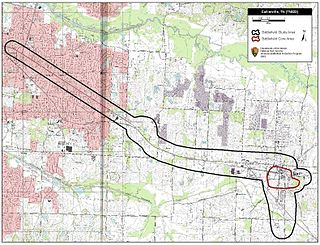Related Research Articles

Moscow is a city in Fayette County, Tennessee, United States. The population was 568 at the 2020 census, 556 at the 2010 census, and 422 at the 2000 census. The town was named after Moscow, Russia, by its founder J. A. Dilliard to honor his wife Alexandra, a native of the Russian city, whom he met on a business trip to Russia in 1834. Moscow, Tennessee maintained close relations with Russia in the years leading to the Civil War, which led to Dilliard’s niece, Lucy Pickens born in La Grange, Tennessee, along with her husband serving as the US ambassador to Russia then after secession serving as Confederate representative to the Russian Emperor during the Civil War. Moscow is also known as the “Land Between Two Rivers,” due to its location after the Army Corps of Engineers rerouted the waterways, moving the main channel west to its current location.

Collierville is a town in Shelby County, Tennessee, United States, and a suburb located in the Memphis metropolitan area. With a population of 51,324 in the 2020 census, Collierville is the third largest municipality in the county after Memphis and Bartlett. It is home to the Carriage Crossing shopping mall and is served by Collierville Schools.
There were three battles of Chattanooga fought in Chattanooga, Tennessee, during the American Civil War:
Chickamauga may refer to:

James Zachariah George was an American lawyer, writer, U.S. politician, Confederate politician, and military officer. He was known as Mississippi's "Great Commoner".

U.S. Route 72 (US 72) is an east–west United States highway that travels for 317.811 miles (511.467 km) from southwestern Tennessee, throughout North Mississippi, North Alabama, and southeastern Tennessee. The highway's western terminus is in Memphis, Tennessee and its eastern terminus is in Chattanooga. It is the only U.S. Highway to begin and end in the same state, yet pass through other states in between. Prior to the U.S. Highway system signage being posted in 1926, the entire route was part of the Lee Highway.

The Second Battle of Collierville, also known as the Action at Collierville, was fought during the American Civil War between the United States (Union) and Confederate States. The fighting occurred during a demonstration on Collierville, Tennessee, by Brigadier-General James R. Chalmers, Confederate States Army.
The Battle of Franklin was a major battle of the American Civil War. It was fought at Franklin, Tennessee, on November 30, 1864, as part of the Franklin–Nashville Campaign.
The Battle of Jackson occurred at Jackson, Mississippi, on May 14, 1863, as part of the Vicksburg campaign of the American Civil War

The American Civil War significantly affected Tennessee, with every county witnessing combat. During the War, Tennessee was a Confederate state, and the last state to officially secede from the Union to join the Confederacy. Tennessee had been threatening to secede since before the Confederacy was even formed, but didn’t officially do so until after the fall of Fort Sumter when public opinion throughout the state drastically shifted. Tennessee seceded in protest to President Lincoln's April 15 Proclamation calling forth 75,000 members of state militias to suppress the rebellion. Tennessee provided the second largest number of troops for the Confederacy, and would also provide more southern unionist soldiers for the Union Army than any other state within the Confederacy.
The 7th Illinois Cavalry Regiment was a cavalry regiment that served in the Union Army during the American Civil War.
Fort Sanders may refer to either of the two United States Army posts named for General William P. Sanders:
The Battle of Farmington is a name given to two different battles during the American Civil War:
7th Indiana Battery Light Artillery was an artillery battery that served in the Union Army during the American Civil War.

The 72nd Indiana Infantry Regiment, also known as 72nd Indiana Mounted Infantry Regiment, was an infantry and mounted infantry regiment that served in the Union Army during the American Civil War. The regiment served as mounted infantry from March 17, 1863, to November 1, 1864, notably as part of the Lightning Brigade. during the Tullahoma and Chickamauga Campaigns.
The 3d Mississippi Cavalry Regiment was a cavalry formation in the Western Theater of the American Civil War commanded by Colonel John McGuirk.
The First Battle of Collierville, also known as the Battle at the Collierville Depot, was fought during the American Civil War between the United States (Union) and Confederate States. The fighting occurred during a raid in West Tennessee and North Mississippi by Brigadier-General James R. Chalmers, Confederate States Army, commanding the expedition.
The 50th Regiment Indiana Infantry was an infantry regiment that served in the Union Army during the American Civil War.
The 66th Regiment Indiana Infantry was an infantry regiment that served in the Union Army during the American Civil War.

Battery K, 1st Illinois Light Artillery Regiment was an artillery battery from Illinois that served in the Union Army during the American Civil War. The battery was organized in January 1862 at Shawneetown and spent most of 1862–1863 on guard duty in western Kentucky. However, part of the battery participated in Grierson's Raid and the Siege of Port Hudson in 1863. The battery fought at Okolona, Tupelo, Spring Hill, and Franklin in 1864. The battery mustered out of Federal service in December 1864; new recruits and re-enlisted veterans transferred to Battery E, 1st Illinois Light Artillery Regiment.
References
- ↑ "Collierville". National Park Service. Retrieved 8 May 2024.